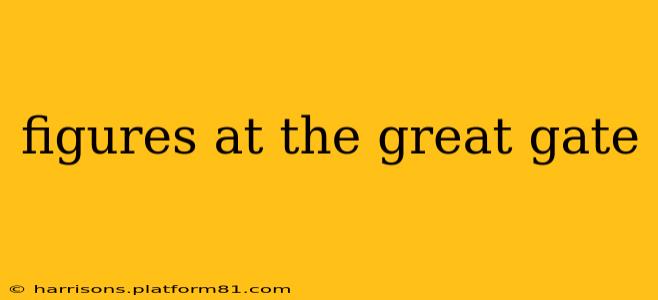Figures at the Great Gate: Unlocking the Mysteries of Iconic Imagery
The phrase "Figures at the Great Gate" evokes a sense of mystery and grandeur. It suggests a powerful scene, a pivotal moment captured in art, architecture, or perhaps even a historical event. But what exactly does it refer to? The answer depends heavily on context, as the phrase itself is not a specific title or description of a single work. Instead, it acts as a powerful descriptor for a wide array of images and interpretations. Let's explore some possible interpretations and delve into the mysteries this evocative phrase holds.
What are some examples of "Figures at the Great Gate"?
This question opens the door to a broad range of artistic and historical contexts. We could be referring to:
-
Religious iconography: Many religions depict significant figures at symbolic gates, entrances to heaven or sacred spaces. Think of the pearly gates in Christian imagery, or the guardians at the gates of temples in various Eastern religions. The "figures" could be deities, angels, saints, or even allegorical representations of virtues or vices. The gate itself symbolizes a transition, a threshold between worlds or realms.
-
Historical paintings or sculptures: Many historical paintings and sculptures depict significant events that take place at a gate, perhaps a royal entrance, a city's fortifications, or a palace gate. These figures could be kings, queens, soldiers, commoners—anyone playing a crucial role in the depicted scene. The gate itself becomes a powerful backdrop, highlighting the significance of the event and the people involved.
-
Architectural details: The phrase might refer to the sculptural elements decorating a grand entrance, such as statues or carvings of mythological creatures or important historical figures. These "figures" are integral to the architectural design, adding visual interest and telling a story through their placement and representation.
-
Literary depictions: In literature, "Figures at the Great Gate" could be a powerful metaphor for a pivotal encounter, a moment of decision, or a symbolic representation of a transition in a character's journey. The gate serves as a boundary, and the figures represent the forces or individuals influencing the character's path.
What is the symbolic meaning of a "Great Gate"?
The "Great Gate" itself carries significant symbolic weight. It often represents:
-
Transition and passage: Gates universally symbolize a transition from one state to another—from the profane to the sacred, from life to death, from one stage of life to the next.
-
Power and authority: Grand gates, particularly those associated with palaces or fortifications, represent power, authority, and control. They mark a boundary, signifying the power held by those who control access.
-
Opportunity and potential: The gate can also represent opportunity and potential. Passing through it signifies entering a new phase of life, accessing new possibilities.
Where can I find examples of art depicting "Figures at the Great Gate"?
To find specific examples, consider searching for art within specific historical periods or cultural contexts. Research terms like "religious iconography gates," "palace gates art history," or "sculptural gates renaissance" to uncover visually rich examples. Many museums and online art archives will offer extensive collections of works that might fit this description. You can also explore different artistic movements and styles for more diverse representations.
What is the significance of the figures themselves?
The significance of the figures depends entirely on the context. Their identities, poses, and interactions all contribute to the overall meaning of the image. Analyzing the figures' attire, expressions, and the objects they hold can provide crucial clues to understanding the narrative or symbolic meaning conveyed.
By considering the context, symbolism, and artistic style, we can begin to unlock the mysteries and multifaceted interpretations behind "Figures at the Great Gate." The phrase's ambiguity is precisely what makes it so captivating, prompting further exploration and understanding of artistic expression and symbolic representation across diverse cultures and time periods.
